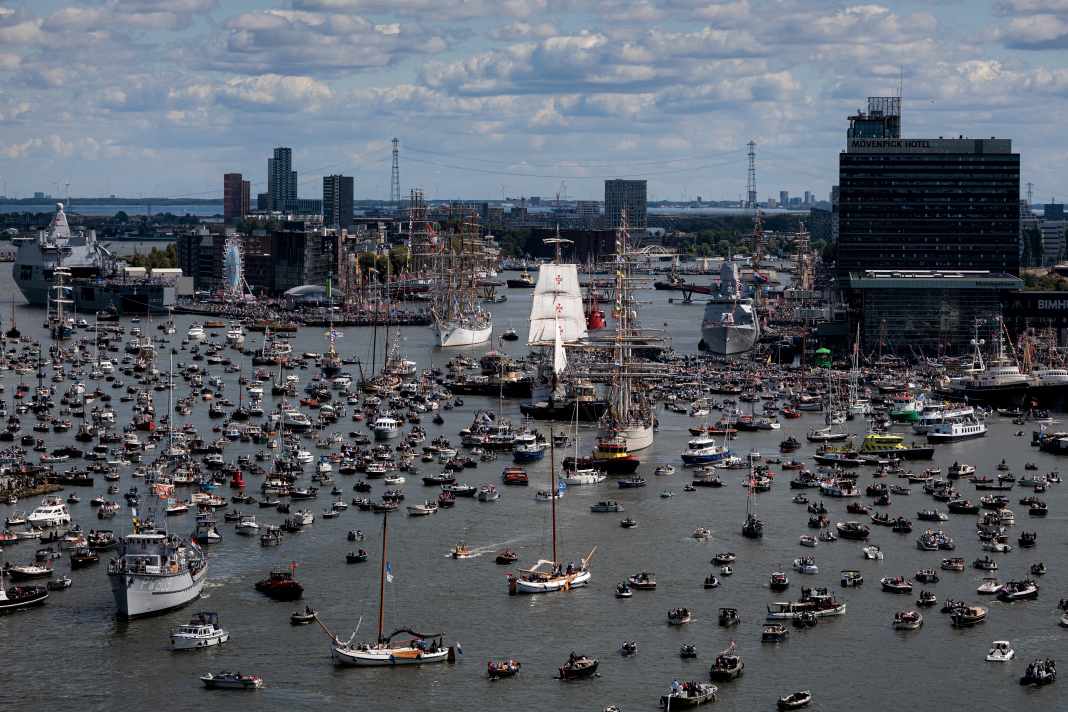





- Anniversary edition for the city's birthday
- International participation and festival atmosphere
- Diverse programme and sustainable focus
- Admiral sailing and ceremonial conclusion
- Impressive realisation by thousands of helpers
- Ceremonial departure of the ships
- Positive balance sheet and future plans
Last Wednesday, tens of thousands of people enthusiastically followed the arrival parade of sailing ships from the shores and from boats. The parade of ships started in the morning in the port of IJmuiden on the North Sea and travelled along the approximately 20-kilometre-long North Sea Canal to Amsterdam. From Germany, the German Navy's training sailing ship, the "Gorch Fock", and the three-masted barque "Alexander von Humboldt II" were among those taking part.
Anniversary edition for the city's birthday
It was a special tenth edition of "Sail Amsterdam": the event took place for the first time 50 years ago, on the occasion of the Dutch capital's 700th birthday. To mark the city's 750th birthday, this year's event was particularly large-scale.
According to the organisers, "Sail Amsterdam" is the largest nautical event in the world and takes place every five years. However, it had to be cancelled in 2020 due to the pandemic. This year, the organisers had expected more than two million visitors during the five-day event - a figure that was actually achieved.
As Mitra van Raalten, General Director of Sail, announced at the end of the event, the visitor numbers from the previous edition in 2015 were exceeded with just under 2.3 million. However, it was not a record: in 2005, Sail Amsterdam attracted 2.6 million people.
International participation and festival atmosphere
Under the motto "united by waves", around 650 historic ships from more than 20 countries took part in the festival, including 40 so-called tall ships, traditionally rigged sailing ships. The ships, including four from the Dutch navy, were moored in Amsterdam's harbours during the event and could be viewed by visitors.
Amsterdam's mayor Femke Halsema arrived on board the Dutch-built clipper "Stad Amsterdam", a 76-metre-long ship inspired by the "Cutty Sark" built in 1869. King Willem-Alexander arrived on the family boat "De Groene Draeck" from Monnickendam, accompanied by former comrades from his time in the navy 40 years ago, as can be read on the royal Instagram account.
Diverse programme and sustainable focus
In addition to a tour of the ships, the festival also offered evening light shows as well as cultural and musical events. "In principle, it is the largest freely accessible event in Europe," explained spokeswoman Marije Harmsen. As well as being able to view the ships on foot, visitors could also book paid tours on the water or sail around the traditional sailing ships in their own boats.
This year's edition emphasised sustainability and featured an academy for students, a kids' club and discussions about Dutch maritime history and its darker aspects such as slavery. For those who wanted a lasting memory, there was even a special Sail 2025 tattoo.
Admiral sailing and ceremonial conclusion
Yesterday, Sunday, the last day of Sail Amsterdam, the traditional admiral sailing took place as a symbolic conclusion to the event. Around one hundred classic ships passed the "Groene Draeck" in formation with patron Prince Maurits on board. Cannon shots rang out from the ship, whereupon the skippers saluted. Visitors were able to take a look at the ships until midday before they were closed to the public in preparation for their departure. Only the naval frigate remained open for sightseeing a little longer.
Impressive realisation by thousands of helpers
The logistical challenge of filling Amsterdam with hundreds of ships was mastered thanks to months of preparation. More than 2,000 volunteers from the Sail organisation worked together with the crew members of the ships, Rijkswaterstaat (Dutch Water Management Authority), the Port Authority and the sea rescue service to make the event a success. Van Raalten spoke of a "magical" Sail that went off without incident. "It was all very cosy and informal. The community on the water with all the ships and crews bringing a piece of their home to our harbour is truly unique."
Ceremonial departure of the ships
Similar to the entry parade, the procession of the ships on Sunday afternoon also attracted a lot of attention. Along the quay walls around the IJ, people stood in several rows, and numerous pleasure boats were seen on the water. Thousands of boats had gathered to see the ships off. People applauded and honked their horns, and some accompanied the tall ships for a while. The uniformed crew members waved back from the decks. The ferries across the IJ remained temporarily at the quay until the biggest crowds had passed.
The "Clipper Stad Amsterdam", which had led the sail-in parade on Wednesday, completed the procession. It was expected that almost all the ships would have left the harbour by 16:30 to sail via the Noordzeekanaal towards the lock at IJmuiden and on to the North Sea.
Positive balance sheet and future plans
Mayor Femke Halsema emphasised that there had been "an unprecedented atmosphere" in Amsterdam over the past few days. "The Sail showed the city at its best: the magnificent ships, the international friendships and the enthusiastic and cheerful visitors." The success of the event has already led to further plans: From 2026, Amsterdam is to have an annual maritime week - a gift to the city to keep the maritime tradition alive between the major Sail events.

